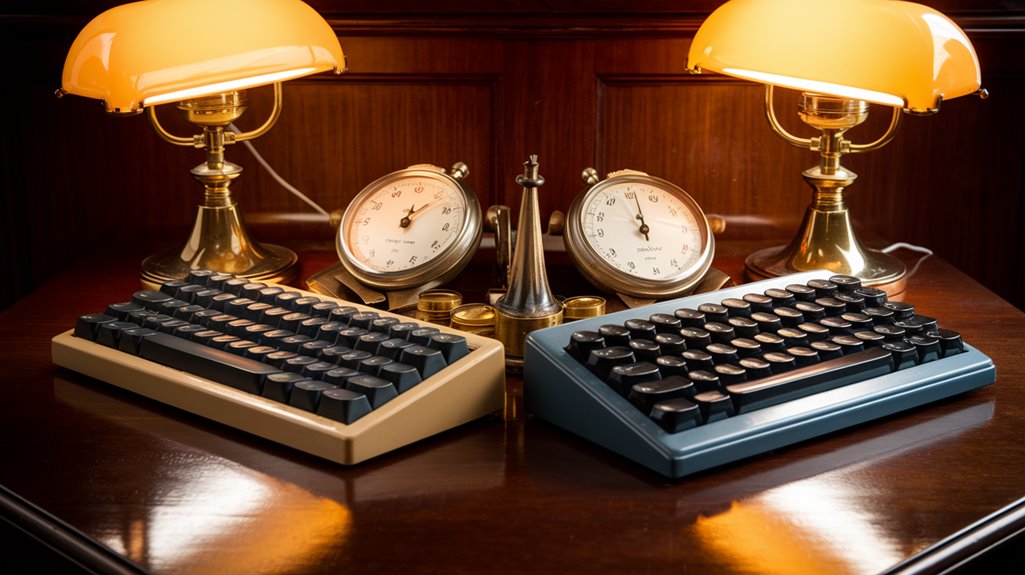Keyboard Wars: Is Dvorak Actually Better Than QWERTY?
You've probably heard the passionate debates about keyboard layouts, especially when someone mentions Dvorak as the "superior" alternative to QWERTY. Whether you're a casual typist or a speed demon churning out 100 words per minute, the choice between these two layouts might affect your daily computer use more than you think. Before you commit to either camp in this decades-old rivalry, let's examine what's really at stake for your typing future.
The Historical Battle: QWERTY vs. Dvorak Origins

When Christopher Latham Sholes invented the QWERTY keyboard in 1874, he couldn't have predicted its lasting impact on typing technology. His design wasn't about efficiency – it was a practical solution to prevent mechanical typewriters from jamming.
The QWERTY history began with Remington & Sons' mass production, which helped establish it as the standard layout. Through the establishment of a typewriter cartel, Remington solidified its control over the market and ensured QWERTY's dominance. The layout persisted despite placing only 32% of keys on the home row, making typing less efficient.
Fast forward to 1936, and you'll find the Dvorak invention emerging as a challenger. August Dvorak created his layout with a focus on typing efficiency and ergonomics, placing common letters on the home row.
While a 1944 Navy study showed promising results with a 74% speed increase, later studies couldn't replicate this success. Despite Dvorak's theoretical advantages, QWERTY's early market dominance and widespread adoption proved too difficult to overcome.
Ergonomics and Efficiency Face-Off
While both layouts claim superiority, Dvorak's ergonomic design offers distinct advantages over QWERTY's traditional arrangement.
You'll find commonly used letters positioned on the home row, reducing finger travel and strain during extended typing sessions. This strategic placement aims to enhance typing efficiency and create a more natural flow for your hands.
However, you'll need to evaluate the significant learning curve that comes with switching layouts. The transition typically requires three months of practice before achieving touch typing proficiency. Retraining your muscle memory requires dedication, and you might face compatibility challenges on various systems.
While Dvorak's ergonomic benefits can lead to increased comfort and reduced wrist pain, alternative solutions like ergonomic keyboards or hybrid layouts such as Colemak might better suit your needs, especially if you're a casual typist who doesn't require heavy daily typing.
Speed and Performance: Myth vs. Reality
Despite decades of debate over typing speed superiority, the real-world performance differences between Dvorak and QWERTY layouts aren't as dramatic as early studies suggested.
Common typing myths about Dvorak's overwhelming advantages have been challenged by modern speed comparisons, which show minimal differences between the two layouts. A key study by the General Services Administration found that retraining on Dvorak actually took longer than QWERTY to reach proficient speeds.
When you're considering switching layouts, keep these key findings in mind:
- High-speed typists (150+ WPM) likely won't see significant improvements by switching to Dvorak
- Slower typists (around 50 WPM) might benefit more from Dvorak's ergonomic design
- You'll need 100+ hours of practice to achieve comparable speeds after switching
While Dvorak offers slightly better movement efficiency by placing common letters on the home row, the practical advantages in typing speed often don't justify the extensive retraining time for most users. Modern typing tests show that QWERTY users peak at 104 words per minute, demonstrating that traditional layouts can achieve impressive speeds.
The Learning Curve and Adaptation Process
Since shifting to Dvorak requires significant dedication, you'll need to prepare for an intensive learning journey. Expect a two to three-week period before you can type comfortably, though full mastery may take months. Your productivity will initially drop as you develop new muscle memory. Modern operating systems make it easy to switch between layouts, providing flexibility during the transition period.
Various learning strategies can ease this adjustment. You might use keyboard stickers and typing software while establishing consistent practice techniques. Daily use is essential for faster adaptation. According to data, it takes approximately three months to achieve typing speeds comparable to QWERTY proficiency.
If you're planning to maintain both layouts, try designating specific keyboards or scenarios for each to create distinct "modes."
The good news is that Dvorak's optimized key arrangement will eventually lead to reduced finger strain and improved typing efficiency. While the learning curve is steep, your investment in time and practice will yield long-term ergonomic benefits.
Making the Switch: Practical Considerations

Before committing to the Dvorak layout, you'll need to weigh several practical factors that could impact your typing experience.
Your current typing habits and speed should guide your decision – if you're already typing at 150 WPM on QWERTY, switching mightn't be worth the effort.
However, if you're typing at slower speeds, Dvorak could offer long-term benefits for both efficiency and ergonomics. Dvorak's design specifically reduces one-finger typing combinations compared to traditional layouts. Learning the new layout is efficient since it typically takes half the time to master compared to QWERTY.
Consider these essential factors before making the change:
- Software compatibility issues may arise with certain applications and tools
- You'll need to invest time in developing new muscle memory
- Professional workflows, especially those relying on keyboard shortcuts, might be disrupted
Remember that while Dvorak promises improved ergonomics and potentially faster typing speeds, the change requires significant dedication and might temporarily impact your productivity as you adapt to the new layout.










